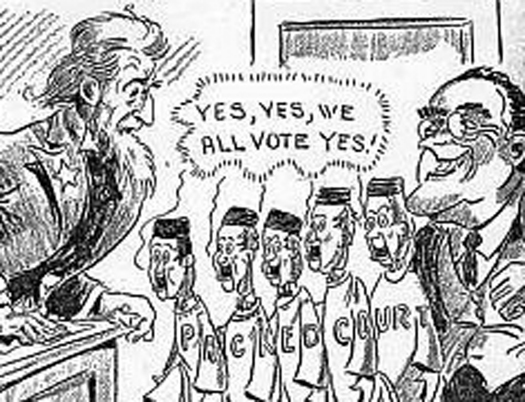| << Chapter < Page | Chapter >> Page > |
Both the executive and legislative branches check and balance the judiciary in many different ways. The president can leave a lasting imprint on the bench through his or her nominations, even long after leaving office. The president may also influence the Court through the solicitor general’s involvement or through the submission of amicus briefs in cases in which the United States is not a party.
President Franklin D.
Roosevelt even attempted to stack the odds in his favor in 1937, with a “court-packing scheme” in which he tried to get a bill passed through Congress that would have reorganized the judiciary and enabled him to appoint up to six additional judges to the high court (
[link] ). The bill never passed, but other presidents have also been accused of trying similar moves at different courts in the federal system. Most recently, some members of Congress suggested that President Obama was attempting to “pack” the District of Columbia Circuit Court of Appeals with three nominees. Obama was filling vacancies, not adding judges, but the “packing” term was still bandied about.

Likewise, Congress has checks on the judiciary. It retains the power to modify the federal court structure and its appellate jurisdiction, and the Senate may accept or reject presidential nominees to the federal courts. Faced with a court ruling that overturns one of its laws, Congress may rewrite the law or even begin a constitutional amendment process.
But the most significant check on the Supreme Court is executive and legislative leverage over the implementation and enforcement of its rulings. This process is called
judicial implementation . While it is true that courts play a major role in policymaking, they have no mechanism to make their rulings a reality. Remember it was Alexander
Hamilton in
Federalist No. 78 who remarked that the courts had “neither force nor will, but merely judgment.” And even years later, when the 1832 Supreme Court ruled the State of Georgia’s seizing of Native American lands unconstitutional,

Notification Switch
Would you like to follow the 'American government' conversation and receive update notifications?